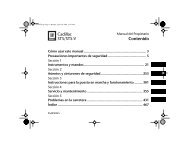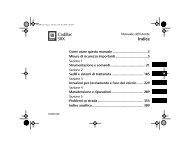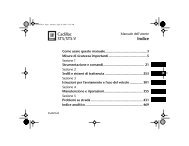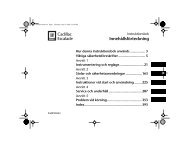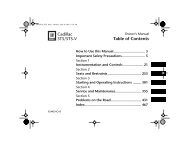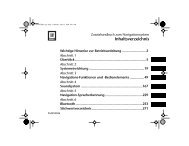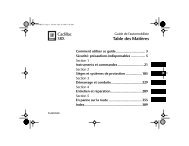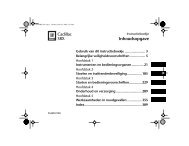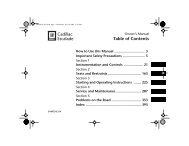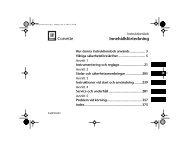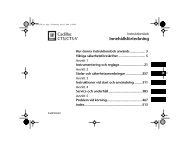Owner's Manual Cadillac BLS - IFS Europe BV
Owner's Manual Cadillac BLS - IFS Europe BV
Owner's Manual Cadillac BLS - IFS Europe BV
You also want an ePaper? Increase the reach of your titles
YUMPU automatically turns print PDFs into web optimized ePapers that Google loves.
460_OM_MY09.book Page 148 Wednesday, April 2, 2008 10:32 AM<br />
148 Starting and driving<br />
All-wheel drive (AWD) 3<br />
Essentially, the system consists of a PTU<br />
(Power Take off Unit), propeller shaft, RDM<br />
(Rear Drive Module which contains an electronically<br />
controlled plate clutch, final drive<br />
gear and differential) and driveshafts. This<br />
system enhances driving characteristics<br />
and stability. The system is always active<br />
and cannot be deactivated. It works<br />
together with the ESP system and the<br />
engine and transmission control modules.<br />
When driving at a constant speed, approx.<br />
95% of the torque is distributed to the front<br />
wheels and approx. 5% to the rear wheels.<br />
The torque is distributed steplessly and<br />
instantaneously between the front and rear<br />
wheels, depending on the driving conditions.<br />
If the car is fitted with eLSD (electronically<br />
controlled plate clutch between the<br />
rear wheels), the torque can also be distributed<br />
individually to the relevant rear wheel.<br />
For optimum system function, the car’s<br />
tyres should not have varying degrees of<br />
wear.<br />
When the AWD system requires service,<br />
the following message is shown on the DIC:<br />
Service XWD.<br />
When the service message is displayed,<br />
the AWD system may have limited functionality<br />
(or be completely disabled in<br />
some cases, i.e. the car switches to<br />
front-wheel drive). Contact a workshop<br />
for information. We recommend that you<br />
contact an authorised <strong>Cadillac</strong> workshop.<br />
Traction Control<br />
System (TCS)<br />
Anti-spin system<br />
WARNING<br />
The TCS system improves stability and<br />
driveability during normal driving, but it<br />
must not be regarded as an opportunity to<br />
increase the speed. The same precautions<br />
as normal for safe cornering and<br />
driving on slippery roads must be<br />
adopted.<br />
How the system works<br />
The Traction Control System (TCS) is<br />
designed to reduce wheelspin and so to<br />
give the car the best possible tractive force,<br />
together with enhanced driveability and<br />
greater stability.<br />
The TCS system uses information from the<br />
ABS system’s wheel speed sensors to<br />
determine whether any wheel is spinning. If<br />
any wheel is spinning, this is reduced on allwheel<br />
drive cars initially by changing the<br />
torque distribution, secondly by reducing<br />
the engine torque, and thirdly with the aid of<br />
the wheel brakes. On front-wheel drive cars,<br />
wheelspin is reduced initially by reducing<br />
the engine torque, and secondly with the aid<br />
of the wheel brakes.<br />
The advantages of the TCS system are<br />
most apparent when road surface friction is




